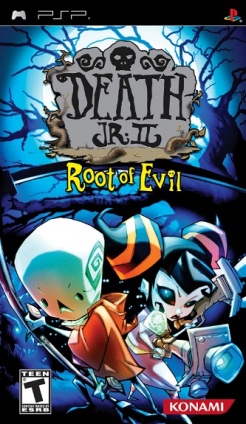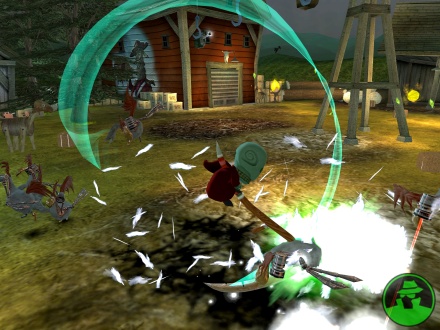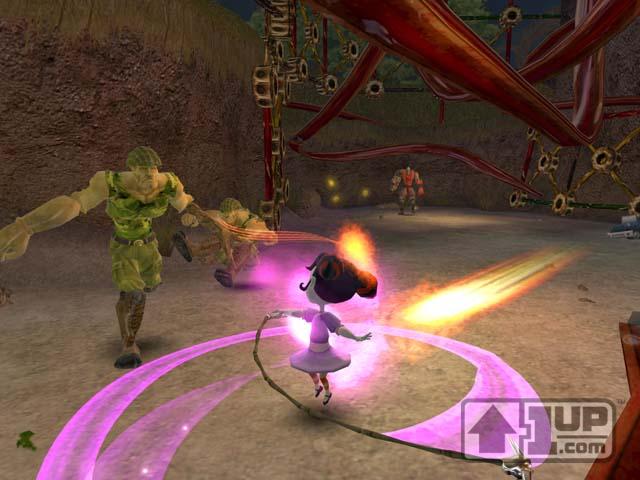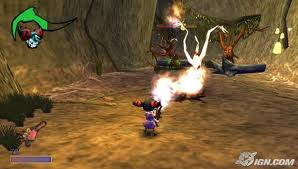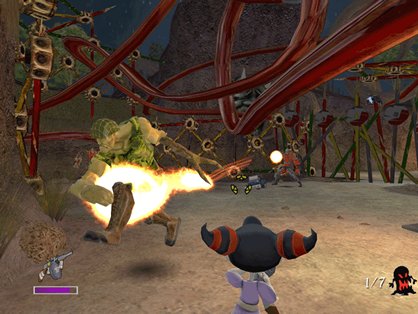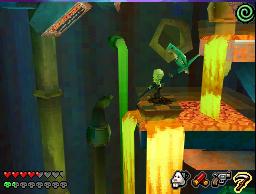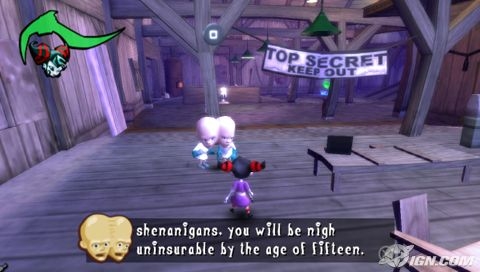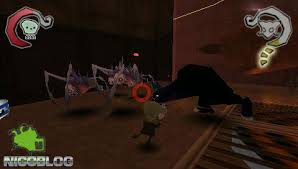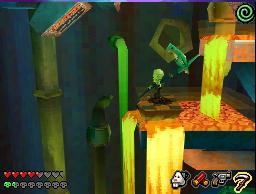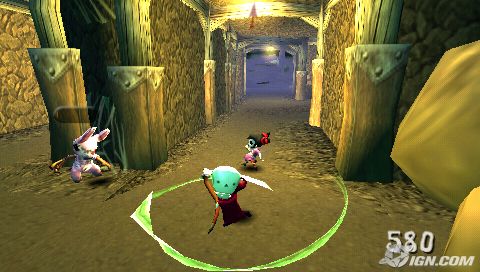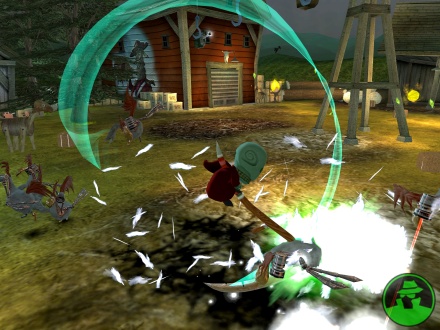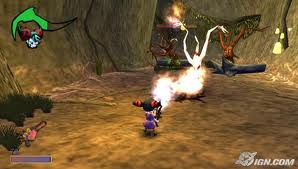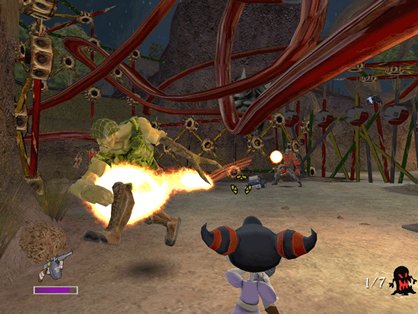Death Jr. II: Root of Evil is the sequel to the launch game for the Sony PSP, Death Jr. In this game players have to rescue Death Jr.’s father, death.
Full Review
Death Jr. II: Root of Evil Review
By, Josh Ferguson
Backdrop
.hack Part 1 Infection (Dot Hack) begins with a bang. Something disastrous happens to your character‘s real world friend, while innocently playing a 20 million-subscriber base, wildly popular online RPG game (MMORPG), The World. To unravel the mystery of your friend’s misfortune, you become an online, ingame rogue hacker, exploring every corner of The World, even some virus-infected ones.
The hero is armed with the special skills of Data Drain and Gate Hack, and some colorful, talented fellow adventurers to fill the two other available party slots. Different adventurers must accompany you depending on the plot‘s development. You have some control over the others in your party, including upgrading them through trades or gifts. You can play only a single class, Twin Blade. Other characters are from different classes, with varied strengths and weaknesses, from a mage type (Wavemaster) to a bully (Heavy Axeman).
Gameplay
Gameplay takes place in three principal areas – towns, fields, and dungeons. Towns house The World’s servers. There, the player can save the game, buy magic scrolls and useful and unique items, store items, buy equipment, and talk and trade with lots of other players in character online. One town has an unusual ranch to check out, a patent homage to an enduring feature of just about every Final Fantasy.
The town’s Chaos Gate provides instant teleportation to a particular wide-open Field, containing monster encounter hotspots, a mystical spring, treasure, and lots of mysterious food. You enter three distinct keywords, some known at the game‘s onset, and others learned through play. Whatever keywords are entered, the difficulty level of the destination is helpfully revealed. This prevents a low-level party from being massacred. Once the keywords are entered, you travel through the Chaos Gate. (You can enter specific keywords learned to continue the plot, do side quests, or do unlimited exploring. Or, you can instruct the Gate to enter random keywords, and take your chances. There‘s also an option to enter any keywords you wish from a word list.) Every Field houses a single Dungeon. The dungeons, where you spend much of the game fighting for your life, are not overly large in size, and always range between three and five average levels.
Many have compared Dot Hack to Phantasy Star Online Episode I and II (PSO) on the Gamecube. Let us gently discredit this. We feel Dot Hack has far better graphics than PSO. The Fields and Dungeons contain many colorful, over stylized backdrops and settings, including weather effects. Dot Hack’s monsters resemble the beautifully-drawn monsters of the later Final Fantasy’s. Dot Hack’s world is gigantic with a seeming infinite number of locations to explore. PSO’s world is relatively small, and plot is threadbare, with meaningless, though fun, side quests, which instill no enthusiasm in the player. Dot Hack’s plot is deep and complex, with each subplot advancing the story just a little bit further. (Remember though, the end of this game in no way comes close to wrapping up the story, to be completed in the three games to be released later this year.) One visual treat, however, was lifted directly from PSO – the cascading rings that accompany the teleportation of characters to and from different areas.
Combat
Dot Hack’s combat engine can best be described as modified real-time. Much like the action-RPG, Kingdom Hearts, button mashing can be effective to beat monsters. Monster combat icons appear as large yellow twirling landmarks. As you approach, the landmark dissolves, monsters come at you big-time, and, undoubtedly, players will feel a healthy adrenaline rush. Some of Dot Hack’s many monsters do not stand around waiting to be pummeled, rather some you need to catch. Dot Hack lets you turn combat almost into a turn-based affair. The player needs only to hit Triangle in the middle of battle to pause the game instantly. From there the player can give orders to the others in the party, anything from healing someone, reviving another, casting a spell, designating a target monster. Without jeopardizing your party from the hailstorm of monster blows, combat becomes a calmer, more strategic, experience. This will help the many action-challenged. Camera angles play a big role in successful combat. You must be facing a monster to do any damage. As in many games, manipulating opposing environmental elements, like fire vs. water, is a key to successful monster combat.
Dot Hack’s cyberspace setting provides a wealth of Wow-inducing outbursts. The Data Drain option in combat is a great example. When a monster’s approaches zero, the player can Data Drain to reduce a horrendous, gigantic steel robot, for example, into a sniveling, puny monster, easily defeated with a single blow. Data Drain always results in a nifty, rare item or essential Virus Cores so you can Gate Hack areas of The World now closed, but needing investigation. One bad side effect – if you defeat, a Data Drained monster, but a single experience point is earned. One REALLY bad side effect – if you Data Drain too often without giving the skill a rest, you may overload and explode. Game Over. In the case of Boss monsters, Data Drain works the same, but what remains is no sniveling puny monster, but a full-blooded slightly less tough monster. All of this makes for interesting and captivating combat, a large part of the game.
Fresh Features
Dot Hack is replete with new and interesting features that kept us riveted.
To start, the entire background and story of a real world gamer becoming a rascal hacker, penetrating deep into a virus-infected online game, is quite novel. Combine this with Dot Hack’s emulating the look and feel of an online game universe. (Message traffic on the web shows many gamers mistakenly believe Dot Hack is a real online MMORPG, along with monthly fees! No real Internet connection is required.)
Just like in the real word, Dot Hack replicates your excitement level when “New” appears before a popular forum or on your email screen. Some of the game involves receiving emails as the plot develops, as well as new, crucial information surfacing on The World’s Board. (Look out for emails challenging you to a strange game of Tag.) The online game world looks very familiar with a bunch of characters wandering around the game’s towns, with the ubiquitous balloon icons talking typical “trash” to each other, even criticizing “newbies“.
Combat grippingly called for surprisingly strategic decision-making to succeed, not related to the usual attack or defend choices. Do you go for experience and upgrade your character or try for some special equipment or a Virus Core, vital to Gate Hacking? The innovative control of other party members became second nature to us after some practice. The game rewards a player taking chances, like entering a Field or Dungeon rated 5 levels above the player’s current level. On the other hand, the game scoffed at players entering areas much lower rated the their current level, by awarding negligible experience points for victory.
Dot Hack takes progress reports to a new level, by slowly unlocking books that contain much in the way of statistics and information. There’s even a monster compendium with tips for defeating them.
Some might complain about the minimal “Save Game” ability, but we thrived on it. You explore a very hostile cyberspace environment without the facility to save. Only in a server-hosting town is saving possible at the local Recorder. We may be a solitary voice in the Wilderness, but we like this throwback to the good old RPG days. Those of you old enough to remember the Wizardry series, may recall those fingernail-biting multi-combat treks back to the Castle just to save the game. In case you’re really stuck deep in a dungeon, a common item will teleport you to the outdoor field, from where you can simply gate back to town from the command menu.
Many pieces of equipment come with distinctive powerful attack, healing, and status skills, essential to combat dominance. The player must tradeoff whether to equip something that will raise defense or offense or something less vigorous that lets you use a powerful skill. Trading is the most successful way to upgrade equipment.
In a first, Dot Hack comes with a 45 minute anime video. This gives some great background on what’s going on in The World, as well as provide clues for completing the game. In a nice twist, voiceovers for game speech can be set for Japanese or English presentation. Listening to the authentic Japanese voices really keeps you glued to the game.
Though some may scoff at what follows as meaningless, we liked the game’s unlocking of some nifty new “toys” to like, some only available when the game is cleared. You can unlock many different background music play lists. Tired of creepy tunes, just switch to something more upbeat, or futuristic. Just like real world gamers, who constantly change their desktop wallpaper, new and different wallpapers are unlocked along the way. Some are concept art of characters, while others are full blown anime renditions of the characters. This makes for great fun, and seems to pump additional energy into the game. As you progress over a dozen special cut scenes or movies will become viewable after defeating the game.
Though Dot Hack’s extras and new wrinkles enhance the RPG game experience, much of the gameplay will ring true to those who enjoy RPG‘s. Expect plenty of exploration in a huge 3D world, frequent monster combat, tons of treasure to earn and discover, upgrading your character’s weapons and armor, and needing to level before tackling pivotal story dungeons. The status screens for the characters and all equipment are well laid out and easy to grasp.
Time for Completion
Game length in hours always concerns many purchasers. A short RPG normally takes a lot of flack, and many online are asking about Dot Hack‘s time for completion. (Some have questioned whether Bandai should have released a single 80 hour game for $50, rather than four 20-hour games for $200 for a single story. This matter is beyond the scope of this review, but our high opinion of this game as a standalone is obvious.) Our experience, playing the plot without doing side quests or extra exploration, is in the 12 to 15-hour range. Players side-questing and extensively exploring, aside from the main plot, can expect to spend 25 hours to complete the game. You can even continue to advance your character, after game completion, to get a jump start on Part 2 due in May. In the next game, your character can be imported from Part 1.
Furthermore, imagine trying to explore every nook and cranny of the fields and dungeons accessible by a large number of 3-word combinations. Doing that would put the game in the 50-hour range, if not more. However, at a certain point, new items dry up, and a single experience point is earned for any defeated monster, no matter how tough.
Shortcomings
While, as is evident above, there is much to recommend in Dot Hack, certain concerns to varying degrees deserve mention.
From the “Why oh why did they leave this out?“ File. Pregame game board traffic and information about the Japanese version released months ago had many salivating for replaying the game in “parody” mode. This mode apparently converted all Dot Hack’s game world characters into satirical comedians. Sorry to say, this highly-anticipated feature is missing from the version released here.
The game requires massive amounts of button pressing. Every item or treasure uncovered from combat victories or exploration (opening chests, searching expired adventure remains, collecting food for Grunty’s, as examples) must be confirmed with a button press. When there could be 50-100 such occurrences in a single dungeon or field, over the course of the game, finger cramps seem inevitable. Baldur’s Gate: Dark Alliance also required lots of bashing for buried treasure and chests, but the items literally flew into your inventory, a much better way to handle this.
The manual is woefully terse and lacking in some crucial information and guidance. While the ingame tutorials fill in many of the gaps, one extremely important gameplay feature is missing from both the manual and tutorials – instructions on control your characters directly during combat.
Final Word
We got a kick out of Dot Hack. The feeling of “just one more dungeon” dominated our lives for the 3 days to completion. The engaging environment held our attention without much effort. The strategic nature of combat, plus the convoluted plot kept us going for hours on end. The constant unlocking of both frivolous and important gameplay features created a “what’s next” anticipation. Now, if I could only read Japanese better, Dot Hack Part 2 is already out in Japan!
Final Grade: B
| In 2005, the original Death Jr. was released for the Sony PlayStation Portable. The game received some praise for its unique and interesting cast of characters, but was hit hard for its troubled camera and combat. Still, in 2006 Konami decided to give the series another shot with the release of Death Jr. II: Root of Evil for the PSP. Will this sequel bring new life to the series? Or should this one stay dead? Read on to find out. |
|
|
Death Jr. II opens up with a short cinema where DJ’s father, Death, is ordering himself a bite to eat at a fast-food joint. Naturally, the boy at the register is caught off-guard and takes off running at the site of Death. As Death stands there puzzled, a large plant creature bursts through the window and begins attacking some of the individuals passing through the mall. According to Death, the individuals there are not destined to die yet, which leads to a fight between the two. Soon after, Death is defeated after a large amount of vines come toward him, trapping him inside. Who is this plant creature and what is her purpose? Well, that isn’t clarified until a few more cinemas later when the player discovers that it was actually DJ and his friend Pandora who freed the creature known as Furi. After their accident, DJ and his pals decide to try and stop Furi before she deals too much trouble, or before his father finds out that it was he who released the creature.
|
| Looking back at the original Death Jr., one of the highlights of the game was the interesting cast of characters. The game’s cast of characters was quite unique, and their actual appearances were top-notch. While there were some interesting enemies along the way, none of them could match the interesting main characters. On the other hand, in Death Jr. II, the game still features the same great cast of characters, but this time around there are some interesting enemies along the way too. My personal favorites in the sequel were the chickens that could shoot lasers. Odd, yes, but definitely one of the more unique and fun random bad guys I’ve found in a game. Some of the others include teddy bears that appear to be missing eyes and other body parts, and mop buckets that roll around the place attacking your characters. |
| Unlike the original Death Jr., the sequel allows players to go through the adventure as either DJ or his friend Pandora. The choice of character doesn’t have any effect on the storyline or any other events in the game, but the two characters do feature some different combat moves and weaponry at their disposal. Even though DJ features mostly the same weapons as the first game, including my personal favorite, C4 Hamsters, Pandora’s are, for the most part, new and unique to the character. As a melee weapon, Pandora uses a whip, and as her range weapons she uses a selection of guns, including freeze guns, tommy-guns, and a flamethrower. While the two characters have a few weapons that are unique to that character, there are also some that are used by the two of them, including the rocket launcher and shotgun. Looking at the list of weapons, there are some interesting and unique weapons found in the game. The problem, though, is that many of them aren’t really necessary and much of the time players will be able to go through without even using the majority of the weapons. In fact, during my playtime as DJ, I had gone through the entire game never using any other weapons aside from my scythe and the twin pistols, which are easily one of the most useful. There are also a few different moves that can be purchased for your characters, but once a few of the more powerful ones are purchased, players can easily fly through some of the game without any use of the others. |
|
Aside from being able to play through as the two characters, the game also allows for some fun co-op action. Using the PSP’s ad-hoc capabilities, players are able to take control of one of the two characters while their friend plays as the other. This is a nice addition for fans of multiplayer action, but there are some flaws here that make some of the co-op adventure a little disappointing. First of all, players cannot simply come in at any time and join in. Instead, the two individuals must completely play through the game together. It is also a little disappointing that once you start the game, players are unable to switch between the two characters, whether it be in co-op or going through the game solo. Plus the co-op doesn’t really add anything to the game, whether it be more enemies, more difficulty, or anything. The co-op only adds what you would assume it would, the ability to play through with a friend, which is nice, but a little disappointing.
|
|
| If you have played the original Death Jr., then you realize that one of the game’s biggest issues was with the camera. With an action game featuring platforming elements similar to this series, a decent camera is not only nice, but a necessity. In the sequel, the developers obviously tried to fix some of the problems with the original game’s camera, and for the most part they did. This time around, players are able to use the shoulder buttons on the PSP to rotate the camera. Also, if the two shoulder buttons are held down, the player can use the analog stick to rotate the camera around in a sort of first-person-type view. Also, the game’s targeting system has also seen somewhat of an upgrade (or downgrade, depending on how you look at it) since the original game. Rather than holding down the two shoulder buttons to lock on to an enemy, the game doesn’t actually allow you to lock on to an enemy. Instead, the actual targeting system has been greatly improved, and the range weapons feature a target, which will appear red when aimed on an enemy. While you could (or at least were supposed to be able to) lock on to an enemy using your melee attacks in the original game, some camera issues made it a lot more difficult than it should be. However, in the sequel the developers completely removed that as an option and focused much more on improving the camera, which I can honestly say they did. |
| One of the nicest things about Death Jr. II: Root of Evil is the amount of checkpoints throughout each of the game’s levels. Any time your character is killed, they will automatically respawn at the most recently visited checkpoint. Aside from that, players can also save their progress at any point in the game, which obviously is ideal for a handheld title. |
|
|
Graphically, Death Jr. II: Root of Evil is a good-looking game. The game features a unique cast of characters that are good looking and some interesting enemies along the way, too. While there aren’t too many, there are some good-looking cinemas to be found in the game as well. The different stages throughout the game are equally nice, and many of them are very large, too. Plus the load times in the game are pretty short, especially considering the size and amount of enemies found in each of the levels.
|
| As far as the sound goes, Death Jr. II doesn’t fare quite as well as it does in other areas of the game. The game does feature some voice acting, which for the most part is done pretty well, but there really isn’t enough of it in the game. Aside from a few cinemas in the game, you really don’t get to hear any of the game’s voice work. Death Jr II also doesn’t feature one of the most impressive soundtracks around, either. It isn’t bad, but there isn’t anything exactly catchy or impressive. Plus, most of the time players will have a bit of difficulty noticing the soundtrack over the constant explosions and screams of DJ being injured. While there are a lot of different sound effects in the game, many of which are done well, there are some, including DJ’s screams, which just become downright annoying. |
| If you were one of the individuals who actually finished the original Death Jr., then you know that the game wasn’t exactly very long. You won’t be beating the game in one sitting (at least I hope), but the game could have been a bit longer. Even though the multiplayer action and two different characters is nice, the longer game time would have helped a lot. There are also a few different difficulties that you can go through, but seeing as how replaying the game won’t be any different even if you choose a different character, I see no real reason for any replay. |
|
Overall Death Jr. II: Root of Evil has improved on many of the problems that were seen in the original. While the sequel carried over some of those flaws, and brought in a few new ones, the fact of the matter is that this is an overall better title than the original. In other words, if you enjoyed the first game, then you will more than likely enjoy its sequel. And if you are a PSP owner looking for an action game heavy on platforming elements, then you may want to check out Death Jr. II: Root of Evil.
|
|

